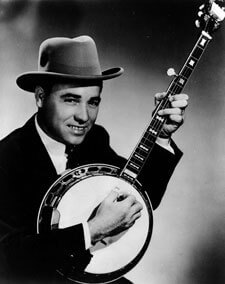
In all of American popular music, Earl Scruggs stands as one of the very few musicians who singularly changed performance practice on their instruments and in the process birthed an entirely new genre. Without him, bluegrass music as we know it would almost certainly never have happened. And countless young players might never have chosen the banjo as their vehicle for creativity.
Prior to Scruggs, the banjo was played through variations of a strumming technique. From the guitar pick approach of New Orleans jazz pioneer Johnny St. Cyr and the clawhammer and frailing patterns of David “Stringbean” Akeman and Uncle Dave Macon, going all the way back to players from before the Civil War whose names are long forgotten, it was treated as a rhythm device mainly to accompany vocals.
That started to change around 1928, when 4-year-old Earl Eugene Scruggs began listening to his brother Junie play banjo at home on the family farm in Flint Hill, N.C. Mother Maybelle Carter soon caught his attention with her “Carter scratch” style, in which she articulated melodies on the low strings of her guitar with her thumb while chording with the rest of her right-hand fingers. This was the seed of what the world now knows as Scruggs’ “three-finger” approach: Rather than strum or frail, he would pluck the strings, often in syncopated arpeggios, which enabled him to expand the instrument’s rhythmic range as well as explore its potential as a solo voice.
People began to notice this new sound when Scruggs joined the Morris Brothers in 1939, taking the place of Don Reno. He left the farm and went full-time into music in 1945 with Lost John Miller and the Allied Kentuckians. They played mainly over WNOX in Knoxville, Tenn., as well as on a weekly program at WSM in Nashville. Jim Shumate heard him on the latter gig and didn’t hesitate to recommend him to Bill Monroe after Stringbean had decided to leave the Blue Grass Boys.
With Monroe from December 1945 through early 1948, Scruggs played the key role in defining the parameters of bluegrass music. His bandmate Lester Flatt tendered his resignation a few weeks later after Scruggs left, and they joined with bassist Howard Watts, aka Cedric Rainwater, to form the first incarnation of the Lester Flatt, Earl Scruggs and the Foggy Mountain Boys. Named after the Carter Family song “Foggy Mountain Top,” they debuted in January 1948 on WDVA in Danville, Va. By the time they dissolved the group in February 1969, they had made household names of themselves as Flatt & Scruggs and brought the music they’d helped create to fans throughout the world.
Milestones were many during their long run. In 1960, they performed at the Newport Folk Festival for the second time and live on the CBS television special “The Revlon Revue: Folk Sound, USA.” Two years later, they headlined at Carnegie Hall and recorded “The Ballad of Jed Clampett” as the theme for “The Beverly Hillbillies,” which became the first bluegrass single to peak at No. 1 and was nominated for a Grammy. Later, in 1968, they would win a Grammy for Best Country Performance, Duo or Group — Vocal or Instrumental, for their rendition of “Foggy Mountain Breakdown.”
As time passed, creative differences emerged between the longtime partners. Where Flatt adhered to the traditions of bluegrass music and its antecedents, Scruggs stayed open to new possibilities. Shortly after their split, the Earl Scruggs Revue was formed, featuring Earl’s sons Gary and Randy, along with pianist Bob Wilson, drummer Jody Maphis and, later on, a third son, Steve, and fiddler Vassar Clements.
Their repertoire embraced contemporary tunes by Bob Dylan, Joan Baez and Michael Nesmith, and ingeniously blended elements of bluegrass, Country and rock. Its members joined Arlo Guthrie, the Nitty Gritty Dirt Band, Linda Ronstadt and others on Scruggs’ 1972 album I Saw the Light with a Little Help from My Friends, which is credited with inspiring the all-star, genre-hopping series of Will the Circle Be Unbroken albums. He even opened the door in Nashville to female executives by choosing his wife, Louise Certain Scruggs, to manage him in 1956.
Scruggs took home three Grammys, for Best Country Collaboration with Vocals (“Same Old Train,” from the compilation album A Tribute to Tradition, 1998), Best Country Instrumental Performance (“Foggy Mountain Breakdown,” from Earl Scruggs and Friends, 2001) and Best Country Instrumental Performance (“Earl’s Breakdown,” 2004). He was inducted into CMA’s Country Music Hall of Fame along with Lester Flatt in 1985 and was honored separately with a star on the Hollywood Walk of Fame in 2003. And in 2008, he received the Grammy Lifetime Achievement Award.
Hailed by The New York Times as “the Paganini of the five-string banjo,” Scruggs died peacefully in Nashville on March 28.
* * * * * * *
By Bob Doerschuk
Used by Permission © 2012 CMA Close Up® News Service / Country Music Association®, Inc.





